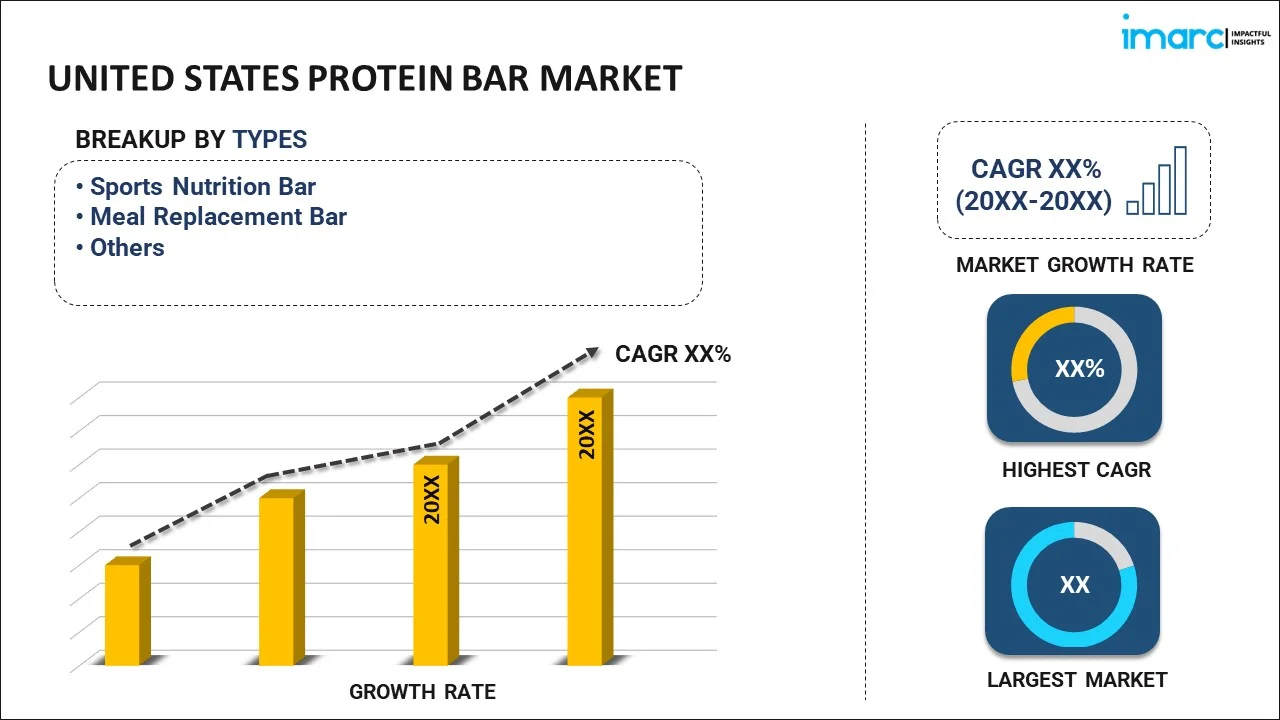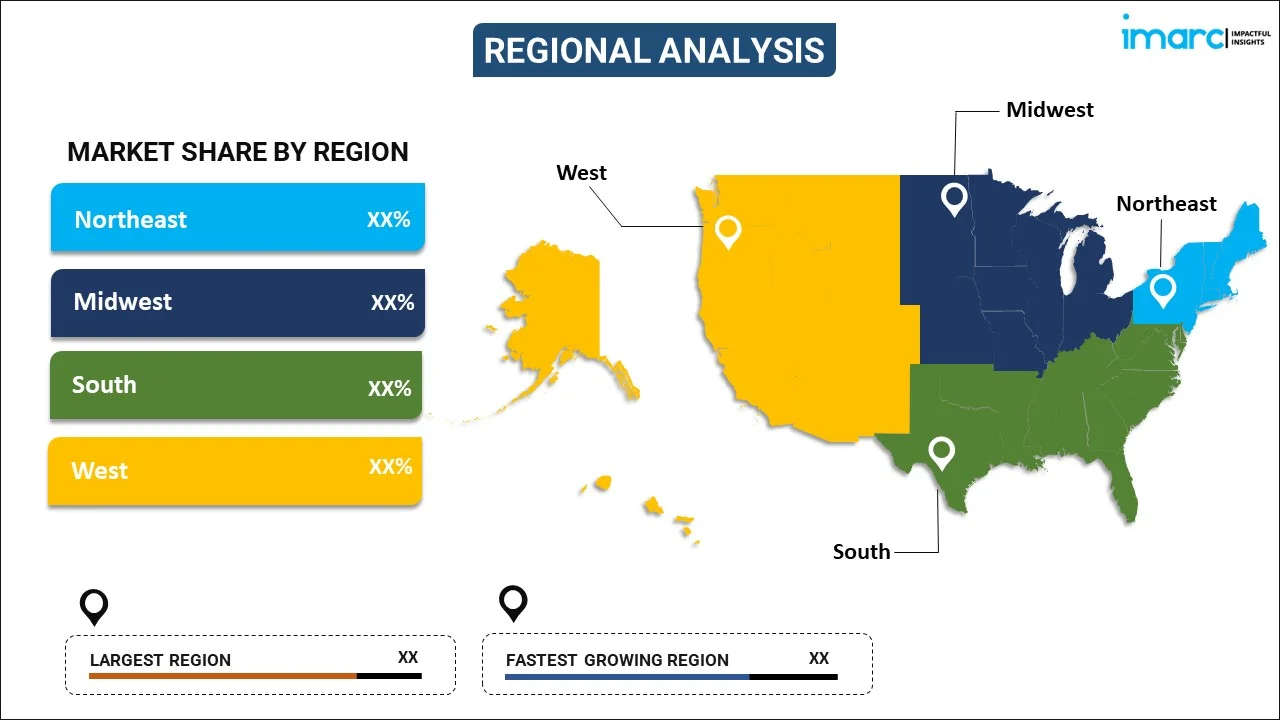
United States Protein Bar Market Report by Type (Sports Nutrition Bar, Meal Replacement Bar, and Others), Source (Plant-Based, Animal-Based), Distribution Channel (Supermarkets and Hypermarket, Convenience Stores, Specialty Stores, Online Stores, and Others), and Region 2025-2033
Market Overview:
United States protein bar market size is projected to exhibit a growth rate (CAGR) of 5.45% during 2025-2033. The increasing availability of protein bars in various retail outlets and the growth of e-commerce platforms that have increased accessibility for consumers, is driving the market.
United States Protein Bar Market Analysis:
- Health consciousness increases demand for protein bars as functional snack foods.
- Culture of fitness accelerates uptake among sports and active lifestyle consumers.
- New flavors and textures capture consumers with diverse taste preferences.
- Diet-specific formulations extend reach to keto, vegan, and gluten-free consumer bases.
- Protein bars deliver lifestyles as meal replacement or on-the-go nutrition solutions.
|
Report Attribute
|
Key Statistics
|
|---|---|
|
Base Year
|
2024
|
|
Forecast Years
|
2025-2033
|
|
Historical Years
|
2019-2024
|
| Market Growth Rate 2025-2033 | 5.45% |
A protein bar is a convenient and portable food product designed to supplement protein intake. Typically composed of various protein sources such as whey, soy, or pea protein, these bars serve as a quick and accessible way for individuals to meet their protein requirements, especially for those engaged in fitness and active lifestyles. Protein bars often contain a balanced combination of macronutrients, including carbohydrates and fats, making them a convenient on-the-go snack or meal replacement. The protein content supports muscle repair and growth, making them popular among athletes, fitness enthusiasts, and individuals aiming to increase their protein intake. With a variety of flavors and formulations available, protein bars cater to different dietary preferences and requirements. However, it's essential to read labels carefully, considering factors like sugar content and additives, to ensure the nutritional alignment with individual health and fitness goals.
United States Protein Bar Market Trends:
Increased Health Awareness and Protein Awareness
Heightened health awareness among American consumers has contributed strongly to protein bar United States protein bar market size. Accelerating numbers of people now value balanced nutrition, especially protein consumption, as a way to promote muscle growth, control weight, and promote general well-being. This knowledge has transformed snacking behavior from rich, high-sugar content foods to more functional, dense nutrient products. Protein bars, being package-friendly and easy to consume, have become a consumer's choice of choice when health-conscious lifestyles are pursued without letting convenience take a back seat. In addition, the growing awareness of protein's satiating and metabolic benefits has made it an integral part of dietary regimens on a day-to-day basis. With nutritional guidelines drawing more and more focus towards food sources high in protein, protein bars provide a convenient solution in various demographic segments. This amplified emphasis on individual health and preventive nutrition is likely to continue driving demand, propelling United States protein bar market share.
Impact of Fitness Culture and Active Lifestyles
The spread of fitness culture within the United States has fueled the popularity of protein bars as a fundamental diet item among active consumers. From athletes and gym members to weekend warriors, protein bars provide an easy source of energy and recovery fuel after exercise. How easy it is to have a high-protein snack before or after exercise has made these bars an essential part of performance nutrition. Moreover, fitness celebrities, social media marketing campaigns, and health brands have boosted protein bar exposure, making them synonymous with strength training, endurance sports, and body sculpting, boosting United States protein bar market trends. This is not a phenomenon exclusive to elite athletes, normal consumers more and more involve themselves in everyday fitness regimens and look for affordable means to support their endeavors. As participation in physical activity like running, cycling, and weightlifting keeps on increasing, protein bars are turning into go-to snacks to fuel movement and recovery. This further boosts their market growth throughout the United States.
Product Innovation and Lifestyle-Oriented Preferences
Ingredient innovation and taste profiles have been instrumental in driving consumer adoption and loyalty in states protein bar market US. Companies continue to launch new ingredients that respond to changing dietary patterns like keto, vegan, paleo, and gluten-free diets. This variety makes protein bars accessible to various consumer segments ranging from clean-eaters to indulgent consumers. Increased flavor, texture, and variety, like dessert-style or savory flavor have made protein bars not only utilitarian but desirable. For instance, in August 2024, Barebells debuted a Key Lime Pie protein bar in the U.S. alone, with 20g of protein and zero added sugar, adding to its roster with a citrus-hued, gym-approved flavor. At the same time, environmentally friendly packaging and natural ingredient procurement have emerged as central issues for today's consumers. Furthermore, professionals and students on-the-go are finding themselves relying on protein bars as meal substitutes or hunger suppressors in between busy schedules. The positioning of protein bars alongside larger lifestyle objectives whether weight loss, sustainability, or time management remains the driving force behind redefining the market ecosystem. These advancements enable long-term consumer participation, further cementing protein bars' position as a dynamic category within healthy snacking.
United States Protein Bar Market Segmentation:
IMARC Group provides an analysis of the key trends in each segment of the market, along with forecasts at the country level for 2025-2033. Our report has categorized the market based on type, source, and distribution channel.
Type Insights:

To get more information on this market, Request Sample
- Sports Nutrition Bar
- Meal Replacement Bar
- Others
The report has provided a detailed breakup and analysis of the market based on the type. This includes sports nutrition bar, meal replacement bar, and others.
Source Insights:
- Plant-Based
- Animal-Based
A detailed breakup and analysis of the market based on the source have also been provided in the report. This includes plant-based and animal-based.
Distribution Channel Insights:
- Supermarkets and Hypermarkets
- Convenience Stores
- Specialty Stores
- Online Stores
- Others
The report has provided a detailed breakup and analysis of the market based on the distribution channel. This includes supermarkets and hypermarkets, convenience stores, specialty stores, online stores, and others.
Regional Insights:

- Northeast
- Midwest
- South
- West
The report has also provided a comprehensive analysis of all the major regional markets, which include Northeast, Midwest, South, and West.
Competitive Landscape:
The market research report has also provided a comprehensive analysis of the competitive landscape in the market. Competitive analysis such as market structure, key player positioning, top winning strategies, competitive dashboard, and company evaluation quadrant has been covered in the report. Also, detailed profiles of all major companies have been provided.
Latest News and Developments:
- In May of 2025, CLIF BUILDERS introduced three new protein bars, including an OREO-flavored bar and Reduced Sugar Crispy bars in Almond Salted Caramel and Peanut Butter Chocolate. These bars provide up to 20g of protein and are designed for health-oriented consumers who demand rich, indulgent on-the-go nutrition without artificial sweeteners.
- In June 2024, The Hershey Company subsidiary ONE Brands introduced two new high-protein bars: Reese's Peanut Butter Lovers and Hershey's Cookies 'n' Crème. Both bars contain 18 grams of protein and 3 grams of sugar, combining signature candy flavors with nutritional benefit as part of Hershey's growing portfolio of Better-For-You snacks.
- In August 2024, Pure Protein from 1440 Foods introduced new Sundae Cone and Brookie flavored protein bars and retro shake flavors such as Galactic Brownie and Caramel Churro. At 19g protein and less sugar per bar, and gluten-free, these snacks rolled out at Walmart, joined by plant-based Nut Bars and savory Popped Crisps to fuel back-to-school health.
United States Protein Bar Market Report Coverage:
| Report Features | Details |
|---|---|
| Base Year of the Analysis | 2024 |
| Historical Period | 2019-2024 |
| Forecast Period | 2025-2033 |
| Units | Million USD |
| Scope of the Report | Exploration of Historical and Forecast Trends, Industry Catalysts and Challenges, Segment-Wise Historical and Predictive Market Assessment:
|
| Types Covered | Sports Nutrition Bar, Meal Replacement Bar, Others |
| Sources Covered | Plant-Based, Animal-Based |
| Distribution Channels Covered | Supermarkets and Hypermarket, Convenience Stores, Specialty Stores, Online Stores, Others |
| Regions Covered | Northeast, Midwest, South, West |
| Customization Scope | 10% Free Customization |
| Post-Sale Analyst Support | 10-12 Weeks |
| Delivery Format | PDF and Excel through Email (We can also provide the editable version of the report in PPT/Word format on special request) |
Key Benefits for Stakeholders:
- IMARC’s industry report offers a comprehensive quantitative analysis of various market segments, historical and current market trends, market forecasts, and dynamics of the United States protein bar market from 2019-2033.
- The research report provides the latest information on the market drivers, challenges, and opportunities in the United States protein bar market.
- Porter's five forces analysis assist stakeholders in assessing the impact of new entrants, competitive rivalry, supplier power, buyer power, and the threat of substitution. It helps stakeholders to analyze the level of competition within the United States protein bar industry and its attractiveness.
- Competitive landscape allows stakeholders to understand their competitive environment and provides an insight into the current positions of key players in the market.
Key Questions Answered in This Report
The United States protein bar market platform consists of diverse distribution channels, including supermarkets, convenience stores, health food outlets, fitness centers, and e-commerce platforms. These platforms facilitate access to a wide range of protein-enriched snack bars catering to fitness enthusiasts, busy professionals, and health-conscious consumers seeking convenient, on-the-go nutritional solutions aligned with their dietary preferences and wellness goals.
The United states protein bar market is projected to exhibit a CAGR of 5.45% during 2025-2033.
The United States protein bar market is primarily driven by rising consumer health awareness, growing fitness culture, and the demand for convenient, high-protein snacks. Additional factors include the popularity of weight management diets, busy lifestyles favoring on-the-go nutrition, and product innovation in flavors, ingredients, and functionality. These trends collectively contribute to the sustained growth of the protein bar segment nationwide.
Need more help?
- Speak to our experienced analysts for insights on the current market scenarios.
- Include additional segments and countries to customize the report as per your requirement.
- Gain an unparalleled competitive advantage in your domain by understanding how to utilize the report and positively impacting your operations and revenue.
- For further assistance, please connect with our analysts.
 Request Customization
Request Customization
 Speak to an Analyst
Speak to an Analyst
 Request Brochure
Request Brochure
 Inquire Before Buying
Inquire Before Buying




.webp)




.webp)












